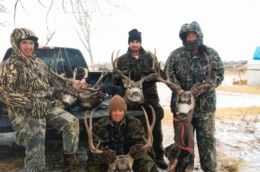The Great White Hunter
Posted By Buck Hunter On In North American New Right | Comments DisabledAs America’s white majority declines, so does hunting. National Public Radio (NPR) has [2] noted that the issuance of hunting licenses is on the decline. This is bad for conservation, since the American government gets 60% of its conservation revenue from fees on hunting licenses and taxes on guns, ammunition, and fishing equipment.
As for why people aren’t hunting as much, the author blames “increased urbanization, restricted access to huntable areas, lack of free time, and the rise of Netflix, video games and all-consuming youth sports.” These things may play a role, but he never mentions the fact that 96% (more like 99%) of hunters are white [3] and that the white population is on the decline.
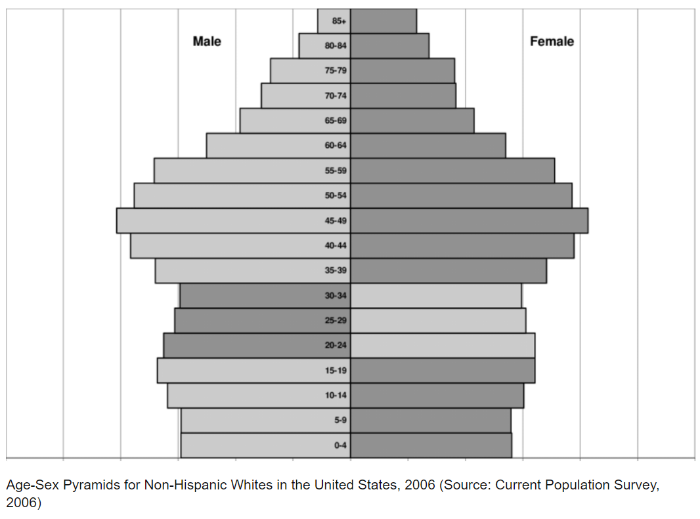 [4]
[4]Figure 1. Non-Hispanic White Population Pyramid from 2006. Image Source: Rumbaut, Young Adults in the United States: A Mid-Decade Profile [5].
 [6]
[6]Figure 2. Non-Hispanic White Population Pyramid from 2010. Image Source: Vogel, Toward a Demographic Understanding of Incarceration Disparities: Race, Ethnicity, and Age Structure [7].
Notice in figure 1 from 2006 and figure 2 from 2010 that there are more whites who are middle aged (these are the baby boomers) than of younger ages. If you flip the male half of these pyramids on their sides, as I’ve done in figure 4, you see that they match snapshots of 2006 and 2010 from a chart in a video titled “2D Hunter Demography [8],” which shows how the number of hunters has declined over the years.
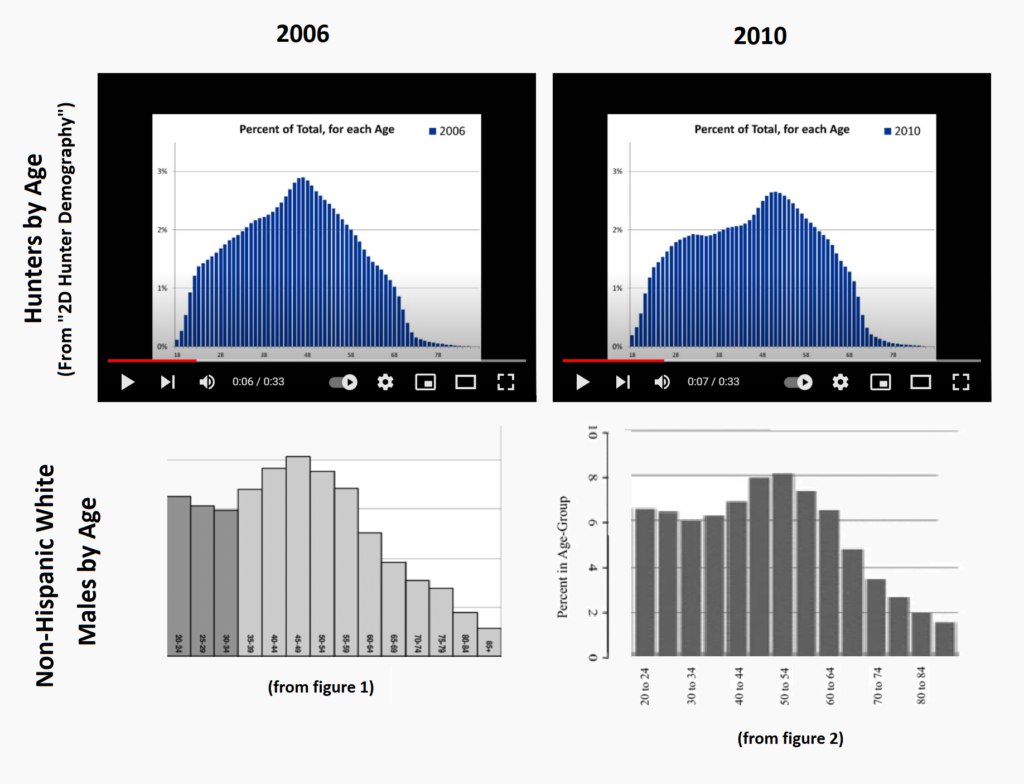 [9]
[9]Figure 3. Flipping population pyramids from figures 1 and 2 on their sides shows they match snapshots of the “2D Hunter Demography [8]“ video in 2006 and 2010.
Conservationists have reason to be cheerful, though, because the Covid lockdowns of 2020 left whites with less to do, so they opted to hunt more. For example, Arizona issued 20% more hunting licenses in 2020 [10]. This is equivalent to whites increasing voter turnout to elect Republican candidates. Nevertheless, it’s only a matter of time before the shrinking white population will no longer be enough to elect Republicans — and it’s only a matter of time before white decline results in a decrease in hunting-derived conservation funding.
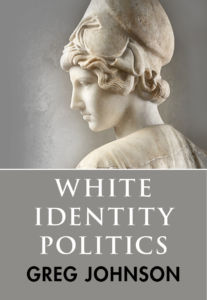 [11]
[11]You can buy Greg Johnson’s White Identity Politics here. [12]
NPR also reports [2] that 5% of Americans have hunting licenses, and nearly all of them are aged 18-65. Since nearly all hunters are white males ages 18-65, and since that demographic comprises about 30% of the white population, we may assume that about one 5/30 or 1/6 white American men are hunters. Counting men who may have skipped a year upon getting a hunting license, considerably more have been hunters at some time. Hunting is a white male thing, and this must be acknowledged. But why is this?
Whites who live in the countryside seem more likely to have Anglo last names. Presumably, these whites would hunt more. I wanted to see if people having such names hunted more. I chose to analyze over 8,100 last names listed in the Ohio Big Buck Club [13] website as having won trophies between 2000 and 2020.[1] [14] I chose Ohio because their white ancestry proportions are similar to those of the nation overall. (For the complete list of names, see here [15]).
One thing that stands out about hunters is that most of them have what I call “pioneer” last names. These are of English, Scotch-Irish, and Scottish ethnicity. I had to lump them together in this category because whites having English and Scotch-Irish ancestry often identify as racially white and ethnically “American,” but we don’t know the exact proportion of each.[2] [16]
 [17]
[17]Figure 4. Ohio non-Hispanic white ancestry proportions. Source: United States Census Bureau [18].
To complicate matters further, 18.5% of whites leave the ethnicity section on the US Census form blank. The government lists their ancestry as “unclassified.” Many theorize that people who have pioneer last names are more likely to do this. In figure 5, the left graph [A] assumes they are no more likely to leave it blank than others, and the right graph [B] assumes that only people having pioneer names leave the section blank. The reality is probably closer to graph [A].
The reason that they are more likely to leave the ethnicity section blank, or identify as “American,” is that their ancestry often goes back many generations, and they can’t keep track of the balance of English and Scotch-Irish ancestry, let alone the small bits of French and Dutch ancestry mixed in. Knowing the exact ancestry proportions would be like knowing the identity of all one’s great-great-great-great-great grandparents.
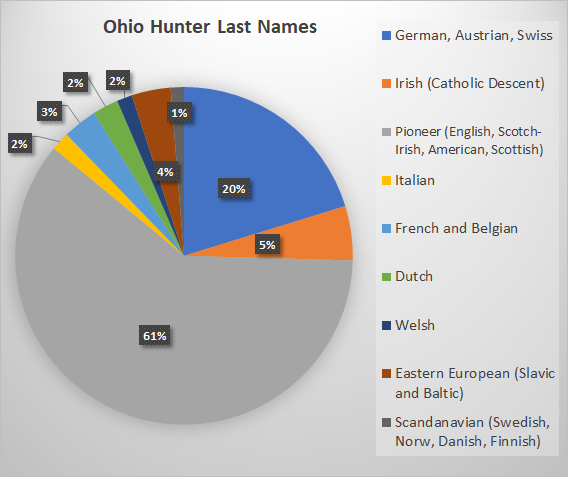 [19]
[19]Figure 5. Ohio Big Buck Club hunters [13] are more likely to have “pioneer” last names (English, Scotch-Irish, “American,” and Scottish).
People descended primarily from more recent arrivals in the mid- to late-nineteenth century have an easier time determining their ancestors’ white ethnicity because they don’t have to trace them as far back, and they often didn’t mix with other white ethnicities in the first few generations. They may need to know eighths and sixteenths, but not 256ths, like descendants in the pioneer group.[3] [20]
It’s also worth noting that by today, most white Americans in the zoomer generation have no more than a quarter of their white ancestry from any one white ethnicity. They are all racially white and equally privy to becoming White Nationalists, but it’s still interesting to see the specific white ancestral mix associated with activities such as hunting, because it can tell us something about the activity.
Contrasting the graphs in figures 4 and 5, it is obvious that hunters in Ohio are more likely to have pioneer last names. They are also just about as likely have French, Dutch, and Welsh last names, two-thirds as likely to have German and Scandinavian last names, half as likely to have Irish Catholic last names, a third as likely to have Eastern European names, and a quarter as likely to have Italian last names.
Anglicization of last names may play some role, but for it to make a large difference, between half and a quarter of non-pioneer white immigrants to America would need to have anglicized their last names, and far fewer than that did.
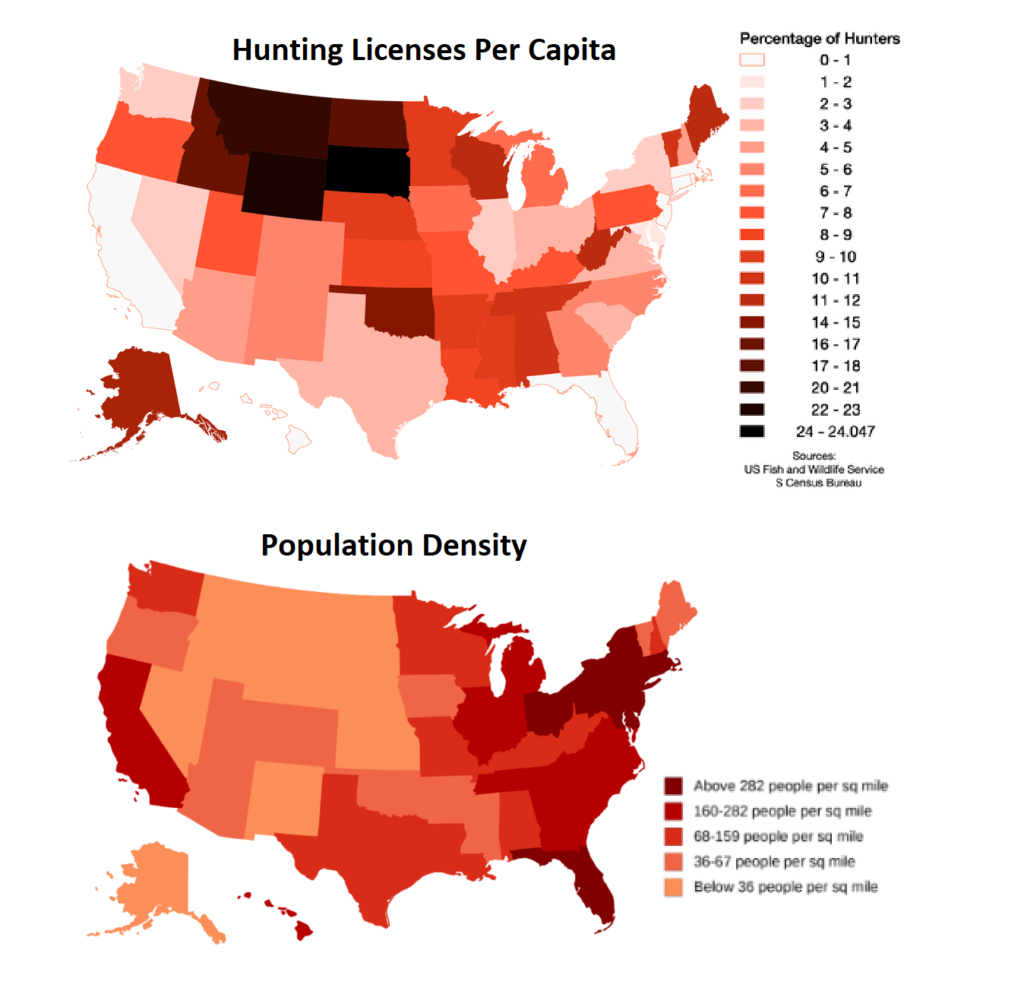 [21]
[21]Figure 6. There is a negative correlation of -0.27 between hunting licenses per capita and population density (see top two maps). Map Sources: Hunting Licenses Per Capita [22], Population Density [23].
Hunting is clearly a white thing, but having land in the country helps. The correlation between hunting licenses per capita in a state and population density is -0.27 (see figure 6), so if people having pioneer last names tend to have more land in the country, then they would have more of an opportunity to hunt on it. (For the record, I tried subtracting cropland [24] from the state, since presumably less hunting takes place on cropland, but the correlation remained about the same at -0.26.) These correlations are strong but not as strong as the correlation of 0.55 between the percentage white [25] a state is and hunting licenses per capita.
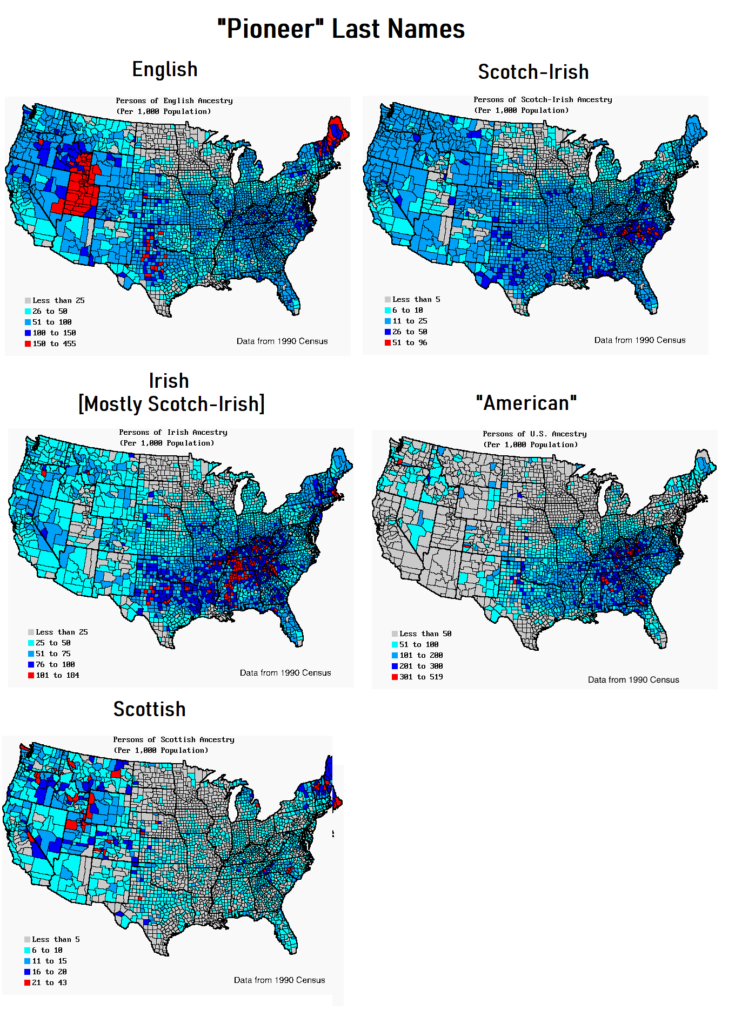 [26]
[26]Figure 7. People having English, Scotch-Irish,” American,” Irish (which pictured here is mostly Scotch-Irish), and Scottish ancestry were among the first to reach America. Maps Source: Minnesota Geospatial Information Office [27].
One reason people having pioneer ancestors appear more likely to hunt is that their ancestors, particularly the English, got to America first and acquired more country land. Examine figure 7 and notice how widely dispersed the “pioneer” ancestries are. They are dispersed relatively evenly throughout the nation, but throughout most states they are mostly in country areas. It is the experience of many white American urbanites that if they drive far enough out into the country, white last names become more likely to be pioneer.
Pioneer namesakes got to Ohio first, but as one can see in figure 8, Germans and Swedish settled the Dakotas, Wisconsin, Minnesota, and other parts of the Midwest at higher rates than pioneer Americans. We’d expect proportionately more hunters to have German and Swedish last names in those states.
Because they had more of an agrarian settlement pattern, it may explain why whites having German last names hunt more than other nineteenth-century white immigrants to America (see figure 10).
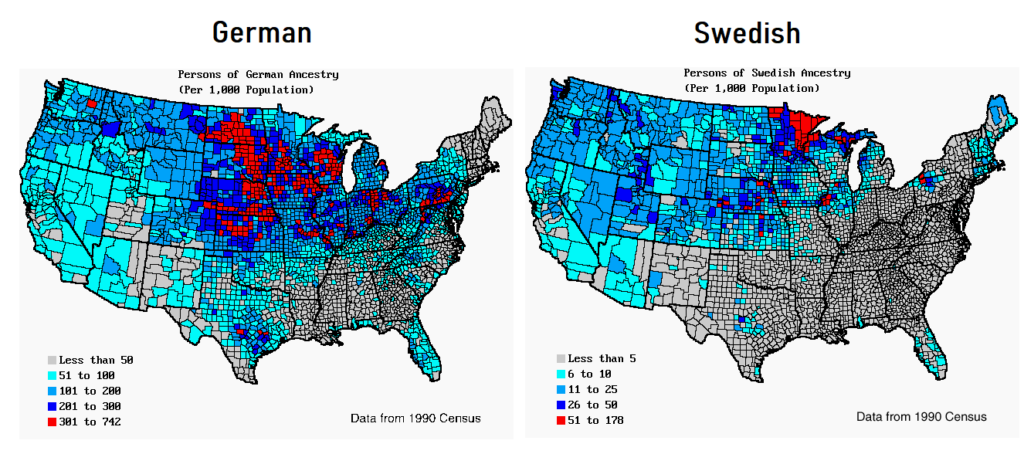 [28]
[28]Figure 8. German immigrants settled at their highest rates in the Midwest and Swedes in Minnesota, but they also dispersed widely throughout the Pacific Northwest and Mount West regions. Maps Source: Minnesota Geospatial Information Office [27].
 [29]
[29]Figure 9. Italians and Eastern Europeans such as Hungarians and Russians came at the start of the twentieth century and congregated in America’s major cities, mostly to work in industrial jobs. Source: Minnesota Geospatial Information Office [27]
As stated earlier, we see the lowest hunting rates among whites who have Irish Catholic, Eastern European, and Italian last names. Their ancestors settled mostly in the northeast and worked in industrial jobs at higher rates than the German and Scandinavian farmers of the Midwest or the pioneers’ descendants. Thus, they would have had less opportunity to hunt or pass the tradition down.
 [30]
[30]Figure 10. Waves of immigration by nation and time period. Source: “Visualizing Two Centuries of U.S. Immigration [31],” Visual Capitalist.
The early twentieth-century Nordicist Madison Grant spends much of his book, The Conquest of a Continent [32], describing the religious and cultural differences between Irish Catholics and the Scotch-Irish. Irish Catholics, along with most of the nineteenth-century white immigrants pictured in figure 10, stuck to the cities, while Scotch-Irish whites came in the eighteenth century, prior to industrialization, and had to be subsistence farmers on the frontier. Hunting would have been crucial to their livelihood during years of bad harvests. Although today, many census respondents in the South claim to be Irish, most of them are in fact Scotch-Irish, which although genetically and physically almost identical to Irish Catholics were Protestants and had a much more dispersed settlement pattern. Because half of all self-identified “Irish” interviewed from 2000 to 2012 [33] claimed to have been raised Protestant, I assumed half of whites identifying as “Irish” on the Census in 2010 were derived from the Scotch-Irish. It may be less than that, but I’m not sure by exactly how much.
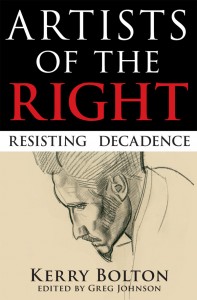 [34]
[34]You can buy Kerry Bolton’s Artists of the Right here [35].
Grant’s father, Gabriel Grant, had participated in nativist anti-immigrant politics in New York City. Nativists opposed the immigration of Irish Catholics. This is the setting for the movie, The Gangs of New York [36], which depicts the draft riots of 1863 when the Irish protested being drafted to fight against the South in the Civil War. Grant used the term “Native American” to refer to the forebears of what I’ve dubbed “pioneer” last names as opposed to immigrants of Irish Catholic, Italian, and Eastern European ancestry. This usage seems to have been unique to him, because according to Google Ngram, no one used them term “Native American” until the Left started using it to describe American Indians in the early 1970s.
In my opinion, the term “Native American” should not be used to describe American Indians because they didn’t discover America. They merely lived simple lives in a small region of the continent. They knew little of the Central or South American continents, or even of the rest of North America. Whites are the ones who discovered the continents and built America. If Mexicans had come to America in the nineteenth and twentieth centuries instead of Italians, Irish, and Poles, then America would be less like America and more like Mexico, but with intelligent, high-trust white workers, things like an efficiency wage worker’s compensation were possible.
Madison Grant was himself an avid hunter [37], and maybe he noticed back in his day that the names of most hunters were pioneer in origin. However, I’m willing to bet that today, pioneer last names correlate more with hunting than pioneer-derived DNA. My reasoning is that hunting is often, or perhaps usually, passed down from father to son. If a man having a pioneer last name married a woman having a German last name, he would pass down the hunting tradition along with his last name to his son, but if a man having a German last name married a woman having a pioneer last name, the father would have been less likely to pass down hunting and of course would not pass down a pioneer last name to his son. Thus, the pioneer last names may be more tied to the hunting tradition than pioneer DNA.
What’s more, if a man having a pioneer last name only had sons, he could pass down land to them along with the hunting tradition. If he only had daughters, he’d pass on the land, but not the tradition. Thus, country land and the hunting tradition tend to be bundled together along with pioneer names, but to a greater extent than pioneer-derived DNA.
Hunting seems to be more of a white thing than anything else. White men having Italian last names, who hunt the least at only 25% of the white average, still hunt at more than three times the rate that Hispanics and Jews do despite the fact that they live in urban environments at similarly high rates. I found only four Jewish last names among the 8,100. Jews anglicized their names more than other groups, because if you’re going to hog all the best jobs and make whites do all the grunt work, it’s best not to be too obvious about it. Still, we’d expect 81 Jews to be on this list given that they are 1% of the Ohio population, and the fact that there are only four detectable ones means they are significantly less likely to hunt than whites, including Italians.
We shouldn’t gauge whiteness on hunting frequency, however, because whites of different ethnicities dominate other pastimes. For example, Southern and Eastern Europeans dominate tennis [39], a sport which is almost all-white, so we could just as easily gauge whiteness on tennis.
White Nationalism is a legitimate concept because whites can be defined genetically [40]. They can also be defined phenotypically, i.e. by their group’s span of intellect, behavior, and appearance. However, suppose for argument’s sake that some white ethnicities are closer to the genetic average of a non-white group such as Turks or Iranians. This doesn’t mean that the distinction between whites and non-whites is illegitimate, however.
Hunters don’t like it when neighbors hunt on their property without permission. The difference between the hunter’s property and the neighbor’s property may be irrelevant if it is well-defined at the property line. The terrain may be identical within a few feet of it on either side, but it doesn’t render the properties the same because away from the property line, one might be heavily forested and the other might be mostly grassland. Thus, even if the boundary area may seem arbitrary where it is drawn, it is useful for describing two very different tracts of land. What’s more, if the hunter’s property has better hunting land, it doesn’t mean he’s obligated to allow his neighbor to shoot deer on his property. Similarly, just because white societies are richer and more peaceful than non-white societies, they don’t have to accept non-whites.
Although people having all possible combinations of white ancestry in America hunt, there is a substratum of whites who live in the country, have a higher frequency of pioneer last names, and hunt at higher rates. Their ancestors set the tone, and whites of other backgrounds followed.
However, non-whites haven’t followed suit. In Ohio’s Big Buck Club, 99.5% of the 8,100 last names from 2000 to 2020 were of non-Hispanic white origin. I found a mere 31 with Spanish last names, but only six had typical Hispanic first names. Most of the others most likely have 100% white ancestry and a Spaniard great-grandfather. Apart from some Hispanic and Jewish last names, there were two Arabic ones, two Iranian, two Filipino, one Indian, and one Laotian. There was also one named Darrell, who may have been black. In all, there were only 45 probable non-whites out of a total of more than 8,100 hunters.
The question is why whites hunt and non-whites, apart from a few Hispanics, don’t. One reason is that whites may be more active in their spare time generally. Frank Raymond [42] makes this claim, specifically with respect to leisure activities, which one would imagine would include hunting. It’s also curious that names from ethnic groups similar to whites such as Hispanics, Iranians, South Asians, and Jews were among those who won hunting trophies in Ohio. It is mainly a white thing, but perhaps to a lesser extent a Caucasoid thing.
Another reason whites hunt more might be that Europe is forested in a similar manner to North America, and thus our ancestors had plenty of opportunity to hunt. The best, most ardent hunters could help their families thrive during good times and survive during bad ones.
Whites derive much of their DNA from Yamnaya cattle herders from the Russian steppes who ate little or no grains for over a thousand years after adopting pastoralism. They supplemented their diet of beef and dairy by fishing and hunting. Having pioneered horseback riding, they could chase deer better than they could on foot. Throw in some domesticated dogs who were able to keep up with the horses, and you’ve got yourself a hunting party [43].
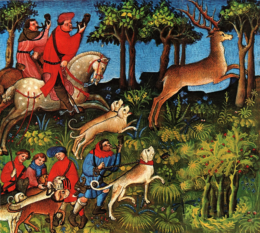 [44]
[44]Medieval Hunting Party, from the Livre de la Chasse (Book of the Hunt) of Gaston III Phoebus, Comte de Foix, fifteenth century.
They’d leave the grasslands for forested valleys [45] during the winter where they could shield their cattle from the cold winds, but while there, they could hunt any game they saw. (Perhaps it’s no coincidence that whites in America hunt mostly in the winter.) Centuries later, Yamnaya people cleared the forests of Western Europe to acquire more pastureland for their herds of cattle, stirring up a lot of game in the process, which must have afforded them hunting opportunities. Thus, hunting has been a basic feature of the white way of life for a long time.
Dogs are happiest when they hunt because they get to exercise their wolf-pack instincts. The most conservation-minded application of this is in the hunting of invasive feral hogs that plague the American South’s ecosystem, especially farmers’ crops. Madison Grant would probably welcome Hispanic Immigrants from the fearsome Dogo Argentino dog breed, who deport the feral hogs from earthly affairs altogether.
Putting a human face on hunters
I’ve described hunters as a group, but I want to put a personal face on them. If you picture the sorts of white guys who’d have names such as these, you probably imagine the most ardent hunters: Wes, Chuck, Hunter (of course), Dusty, Rich, Dalton, Colton, Brock, Rusty, Trent, Shane, Mason, Randy, Jeremy, and Tyler.
These were the most distinctive names on the list of Ohio hunters.
Now I want to describe some hunters I knew growing up. These men are all boomers, and they’re too old to hunt nowadays, but it will enable the reader to put a face to hunters.
No one is blunter than a hunter. Even though they are mostly men of few words, they have little regard for political correctness when they speak. They worked in factories, as truck drivers, as construction workers, and as high school teachers.
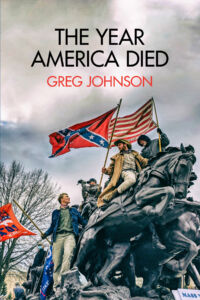 [46]
[46]You can buy Greg Johnson’s The Year America Died here. [47]
Three of them were my friends’ fathers. One of them, who we’ll call Bill, let us drive fast go-carts. It was fun, but Bill’s wife was upset with him because we were only eight years old at the time. My friend showed me a hole Bill had punched in the wall, which he seemed to regard — at least partly — as a token of his father’s strength.
Another, who we’ll call Rich, had an old, beat-up truck with a suspension that was so bad that when he drove over bumpy roads, the vehicle rocked back and forth to the point that we were partially airborne for long stretches. The sentimentalism that led him to keep the truck for that long had good effects in other areas. He was the type of guy who’d always help you when you were down. Most men either ignore you or even make things worse, but he helped you out. He was a tough guy, too, having been a star football player in high school. (One thing I like about white guys is that more of them manage to be both tough as well as kind and civilized. Not as many African-American men are able to strike this balance.)
Then there is my uncle. He used to go to Cabela’s a lot. He hunted with a bow as well as rifles, probably because the season for the former is a bit longer. He would bemoan the occasions when he’d be out on the road and see a turkey without having his bow to shoot it with. He had been a sniper in Vietnam, and like many veterans of that war, came to disagree with it. He gave me some of my favorite clothes, such as a green military jacket. He died recently and received a military funeral.
The hunters I knew were not the type who often impressed you, but they wouldn’t bother you, either. We can idealize the hunter in the abstract, but we shouldn’t idealize the men themselves. Hunters are a set of people. They may be a better set than blacks or Hispanics, but this doesn’t mean they are perfect. If you idealize people on the individual level, you’ll eventually find one who will let you down — and you’ll be lucky if that’s all he does.
White people’s individualist way of thinking is a good way of weeding out bad people from a group, but it makes them weak when competing with non-white groups.
 [48]
[48]Figure 11. Percentage of whites per state correlates with higher average IQ per state. Sources: Visualizing Two Centuries of U.S. Immigration [31], Non-Hispanic Whites 2011 [25], Average IQ By US State [49].
Even if we don’t idealize them as people, we should advocate for hunters’ needs given that they are nearly all white — but we must be realistic about their demographic. In The Conquest of a Continent [32], Madison Grant claimed that Country America had suffered dysgenic fertility; specifically, that there had been a reduction of desirable characteristics in the population due to continual emigration (out-migration). It has been three more generations since then and the brain drain has continued; if he was right then, he’s even more right now.
If there has in fact been a brain drain, it doesn’t appear to have occurred by state, because Montana, for example, is almost all countryside and has among the highest average IQ scores of all the states in figure 11. If Grant was right, it would seem to have happened at the country versus urban level.
Whites who score higher in terms of openness to new experiences on the five-factor model tend to flock to urban areas. Openness is correlated with intelligence, and there is evidence that urban whites are smarter on average. SAT scores in Massachusetts are higher [50] among urban whites than rural whites. Smarter people have been settling in cities for a long time, so brains no longer need to drain to create a difference. However, while the brain drain has persisted for almost a century since Grant wrote Conquest in 1933, it has slowed since the beginning of affirmative action in the 1960s.
What’s more, there is a sort of geographical life-cycle in which country whites move to the cities to start their careers in business or tech, and then return to the country later in life to either raise their families or retire. For this reason, living in the country in one’s twenties can be lonely.
Furthermore, America’s white population is shrinking, and it’s contracting most in the countryside. Barring any changes to settlement patterns, much of whites’ exodus from the countryside is permanent.
Lastly, the low population density in the countryside means that there is little chance of finding people who share one’s intellectual interests there. One can find nice people, hardworking people, and people who do the essential jobs, but it’s hard to have an intellectually stimulating discussion. It’s easier to do that in urban areas — but if you express any Right-wing sentiments, you will be ostracized from most people. Countryside whites are less likely to do that. It’s basically a safe space for white people — as is Cabela’s.
If hunters vote anything like other countryside whites, then I’d be happy restricting voting to hunters. Rural whites voted for Trump at much higher rates than urban ones did, and hunters probably voted for him at even higher rates. I’d especially like to restrict voting to hunters under 40, because young men don’t get paid well enough to survive, let alone buy a house and start a family. Thus, those under 40 understand the need to change the economy’s gerontocratic wage system. Many older men are trapped in a FOX News echo chamber where they blame cancel culture on socialism, when in fact it is a market phenomenon. This is the same market that also wants Hispanics to come to America illegally, of course.
If we are ever to take America back for white Americans, rural Americans will play a strong role. The deadline for this is within the next three decades, because white millennials and zoomers aren’t having enough children to replace themselves, Hispanics are outbreeding them, and America’s borders are more open than ever. In 2014, whites lost majority status among newborns [51], and in the coming decades they will lose plurality status among newborns once Hispanic babies outnumber them.
It’s hard to know how to take the first steps toward reversing America’s decline. The most practical thing to do this hunting season is to buy a hunting license, look up a friend on Facebook who has posted a photo of himself with an “eight pointer,” and ask to go hunting with him. He and his buddies will be more receptive to pro-white ideas than most.
The least you could do is take a trip to Cabela’s or Bass Pro and strike up a conversation, and mention some political topics. The headlines from the mainstream media make the best icebreaker. At the very least, while in the store, you’ll experience what it’s like to shop in a white country — that country being America.
* * *
Counter-Currents has extended special privileges to those who donate $120 or more per year.
- First, donor comments will appear immediately instead of waiting in a moderation queue. (People who abuse this privilege will lose it.)
- Second, donors will have immediate access to all Counter-Currents posts. Non-donors will find that one post a day, five posts a week will be behind a “paywall” and will be available to the general public after 30 days.
To get full access to all content behind the paywall, sign up here:
Paywall Gift Subscriptions
 [52]If you are already behind the paywall and want to share the benefits, Counter-Currents also offers paywall gift subscriptions. We need just five things from you:
[52]If you are already behind the paywall and want to share the benefits, Counter-Currents also offers paywall gift subscriptions. We need just five things from you:
- your payment
- the recipient’s name
- the recipient’s email address
- your name
- your email address
To register, just fill out this form and we will walk you through the payment and registration process. There are a number of different payment options.
Notes
[1] [53] I counted the last names of men with multiple trophies as many times as they had trophies, because their enthusiasm to win should be rewarded given that the quality of one’s interest in hunting matters as much as the quantity of people who hunt.
[2] [54] The reason I had to lump together English, Scotch-Irish, and Scottish last names is because they overlap among the ethnicities. Another is that the US Census category of “American” usually denotes people having English or Scotch-Irish (and thus pioneer) ancestry, and while comparing last names to reported US Census ancestry I couldn’t estimate what percent of last names amongst “American” respondents in Ohio were either English or Scotch-Irish. Because uninformed guesswork would not be appropriate, I was forced to lump them together.
[3] [55] People typically only know anything about their ancestors going back six or more generations if one of them was someone famous, like George Washington or Andrew Jackson. As for non-celebrities, most people only know as far back as the generations of their grandparents or great-grandparents. They may know one set of great-great grandparents if they were mildly rich or high-status, but that’s usually the only reason.
